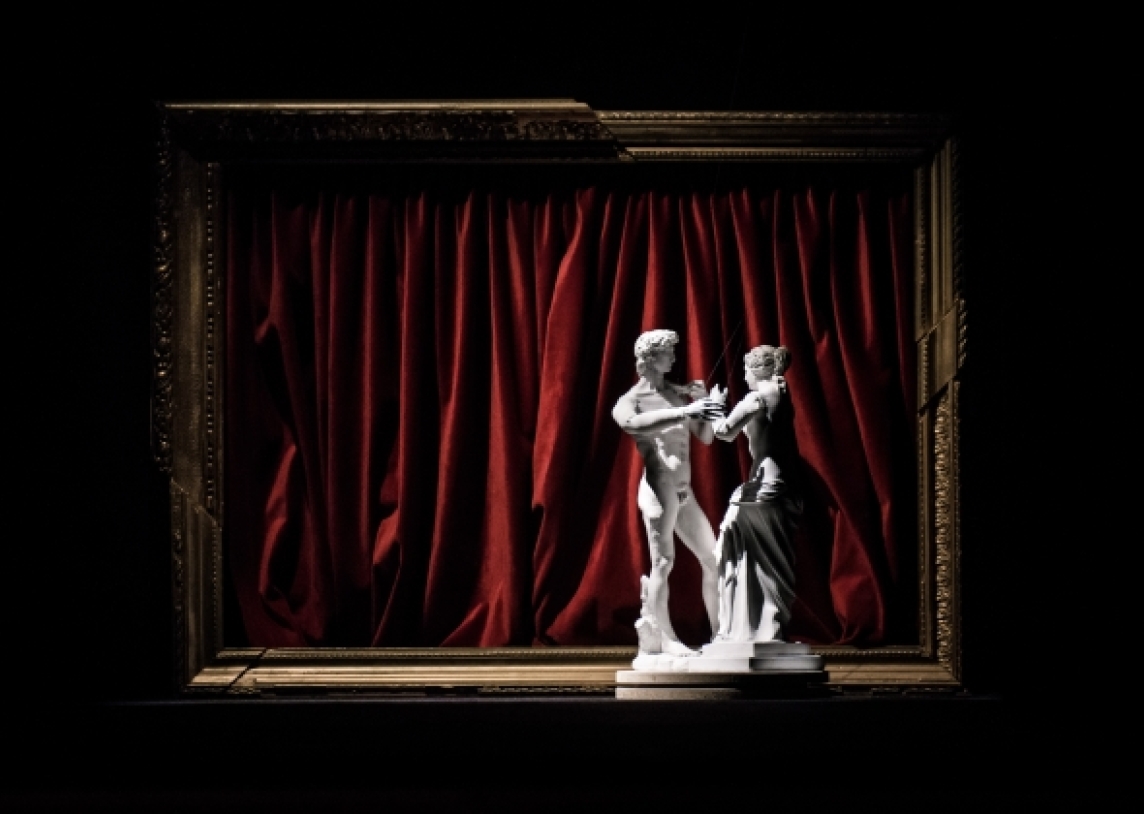News
The Picture of Dorian Gray in A Hall of Distorted Mirrors
The Picture of Dorian Gray in A Hall of Distorted Mirrors
Inesa Vėlavičiūtė
With the original take on a times-old theme, The Picture of Dorian Gray addresses humanity’s deep-seated fears and comprehension of aging and mortality, exploring the synergies between the desire to control time and the fleeting nature of youth and beauty. Based on Oscar Wilde’s 1890 work, this edition of the classic text premiered in 2018 at Vilnius Puppet Theatre Lėlė in Lithuania. Combining static puppets, genre-defying movement and mirror image manipulation, the award-winning director Gintarė Radvilavičiūtė offers a unique theatrical vision rooted in philosophy, psychology and spirituality, challenging mankind’s dysfunctional way of being, confronting the beliefs and values causing one’s self-destruction while in pursuit of happiness and pleasure.
The rising stage curtain invites the audience to observe the beauty and tragedy of Dorian Gray's life, stepping into a time capsule where the essence of the bygone Wilde's era continues to thrive. The narrative follows an aristocratic man whose love for the aesthetics of youth and beauty transforms into a craving for the eternity of both and an obsession that costs him a balanced view of the world and, eventually, his life. Fighting against the laws of nature, the ties binding Dorian and his portrait transcend to a metaphysical level: capturing his external features initially, the portrait gradually changes into the reflection of Dorian’s inner self and his sins, aging instead of him. This metamorphosis and the duality of his personality, and life itself, are expressed through the collision of two opposites on stage: the dynamic – the body movements and mirrors’ optical illusions versus static – the immobile miniature sculptures/puppets and the concept of framing.
The dynamic energy of the performance is channelled through the breath-taking vigour of the actor’s body at work and the use of the mirrors to capture layers of the unreal other in their reflections. The artistic director chooses the medium of mirrors – a symbol of self-awareness and self-centredness as well as vanity – to represent Dorian’s portrait in which he projects himself into. A surrealist masterpiece emerges through the interplay and subtleties of the expertly processed movements, joining and dissolving at the same time, creating a living, evolving thing whose shape is hard to pin down. Positioned and used effectively, mirrors enhance and emphasise the shape of the body and movements, achieving the ultimate liberation from the constraints of reality: the reflections morphing and undulating, shimmering like a ghastly mirage, skewing the natural depiction of the human form. They open another dimension of intriguing angles allowing the viewer to see Dorian’s elaborate facial features, hands and other body parts. “The portrait” becomes an autonomous, independent entity in which Dorian meets his distorted self: all that is irrational, instinctive and hidden in his own psyche.
It is also interesting to note a symbolic reference to the classical Greek myth of Narcissus cleverly incorporated in the way the actor examines his reflection in the mirror. Just as the latter becomes in love with his own reflection in the water and drowns in it, Dorian too becomes lost in the world of endless yearning for beauty and losing a sense of self along the way.
In contrast, the human figure in its static version is represented by the miniature copies of some well-known classical Greek sculptures. “Playing” the novel characters, including Dorian himself, these objects are significant compositional tools in opposing the brevity and fragility of youth, beauty and life pictured in the scenes with mirror props. The sculptures are the everlasting monuments of the idealised beauty and athleticism of the human form. Frozen in time at the moment of their creation, the unchanged appearances are immortalised just like in the portraits. The apparent contradictions evident in the existential terrain Dorian inhabits create an oddly vertiginous way of being: nothing is fixed, and yet everything is fixed, the impossible is attainable, and both are true at the same time. The resulting unity of opposites produces a profound visual and spiritual experience: the mind enters an unrestrained state of imagination and contemplates images, critically exploring the inner perception of the world around, meanwhile still being fully present in the moment.
Another element of the stiffness and immobility in the production is expressed through both physical frames and framing as a social phenomenon. To start with, the setting: the stage is encircled by an oversized picture frame keeping the viewer’s focus on the framed object – the scene, the mirrors are reflecting only what they are faced with and a single string tied to each sculpture puppet is causing the limitation of their moving trajectory within a space. All actions and emotions have to be choreographed with precision in order for the story to be told with enough clarity: there is no spoken language, only a few lines of subtitles above the stage alluding to the characters’ comments on art, beauty and creativity. And finally, the concept of framing, which constructs a fenced social reality ingrained in the minds and perceptions of the story characters, and carries the narrative forward.
Through multiple symbolic references this compelling meditation poses questions both immediate and equally timeless. In a world that is fractured by the varied cultural and philosophical perspectives at play, the production is a powerful return to the centre of gravity, showing humanity what really matters. It’s about the acceptance of having no control over the passage of time and the ephemeral nature of the world around us; otherwise losing the joy of life while concentrating solely on one’s self.

